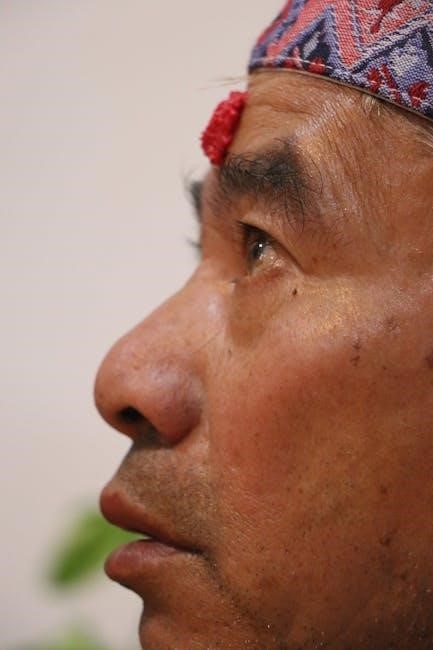rich dad poor dad filetype:pdf
Rich Dad Poor Dad by Robert Kiyosaki challenges traditional views on money, contrasting his two father figures’ financial philosophies. It emphasizes financial literacy, wealth-building strategies, and independence.
Overview of the Book
Rich Dad Poor Dad by Robert Kiyosaki explores the contrasting financial philosophies of his two father figures: his real dad (Poor Dad) and his best friend’s dad (Rich Dad). The book challenges traditional views on money, emphasizing financial independence and wealth-building strategies. It critiques the conventional approach of earning a salary and paying bills, advocating instead for investing in assets and creating passive income streams. The narrative blends personal anecdotes with practical advice, making it a relatable guide for those seeking to escape the cycle of financial struggle and achieve long-term prosperity.
Author Background: Robert Kiyosaki

Robert Kiyosaki, born in 1947 in Hilo, Hawaii, is a renowned entrepreneur, investor, and author. He studied at the U.S. Merchant Marine Academy and later attended the University of Hawaii. Kiyosaki served in the Marine Corps before pursuing business ventures. His early career included founding a company that produced the first nylon Velcro wallet, which eventually led to bankruptcy. Despite setbacks, he rebuilt his fortune through real estate and other investments. Kiyosaki is best known for founding the Rich Dad Company, which advocates for financial education and wealth-building strategies.

The Concept of Two Dads
The book introduces two influential father figures: the author’s educated but financially struggling “Poor Dad” and his friend’s wealthy “Rich Dad,” contrasting their financial philosophies.
Who Were the “Rich Dad” and “Poor Dad”
Robert Kiyosaki’s “Poor Dad” was his biological father, a highly educated man who struggled financially despite his income. In contrast, his “Rich Dad” was his best friend’s father, a successful entrepreneur who amassed wealth through smart investments and financial literacy. The two dads represented opposing views on money: one adhered to traditional employment, while the other embraced entrepreneurship and wealth-building. Their differing philosophies deeply influenced Kiyosaki’s understanding of money and shaped his approach to financial independence.
Contrasting Financial Philosophies
The “Rich Dad” and “Poor Dad” represented opposing financial mindsets. The “Poor Dad,” Kiyosaki’s biological father, believed in traditional employment, job security, and a steady paycheck. He prioritized education and hard work but struggled financially. In contrast, the “Rich Dad,” his friend’s father, focused on building assets, investing, and creating income streams. He emphasized financial independence over a salary, teaching that money should work for you, not the other way around. These contrasting philosophies shaped Kiyosaki’s approach to wealth and challenged conventional views on money and success.

Key Financial Lessons from the Book
Rich Dad Poor Dad teaches financial independence through wealth generation, emphasizing assets over liabilities, and understanding risk. It advocates for passive income and smart investments to build lasting wealth.
Financial Independence and Wealth Generation
Financial independence is a central theme in Rich Dad Poor Dad, achieved by building assets that generate passive income. Kiyosaki distinguishes between assets and liabilities, urging readers to focus on acquiring income-producing assets. He advocates for moving from the “income statement” to the “balance sheet,” emphasizing ownership of businesses and investments. Wealth generation involves leveraging tax advantages, managing risk, and creating multiple income streams. Kiyosaki encourages readers to adopt an entrepreneurial mindset, invest in financial education, and take control of their financial future to escape the cycle of earning a paycheck.
The Importance of Assets Over Liabilities
In Rich Dad Poor Dad, Robert Kiyosaki emphasizes the importance of distinguishing between assets and liabilities. Assets generate income, such as real estate or businesses, while liabilities drain finances, like loans or credit card debt. Kiyosaki argues that most people confuse liabilities with assets, hindering wealth growth. He advocates for acquiring income-producing assets to build wealth and achieve financial freedom. This mindset shift is crucial for moving from earning a paycheck to creating passive income streams that support long-term financial independence.
Understanding and Managing Financial Risk
Robert Kiyosaki stresses the importance of understanding and managing financial risk in Rich Dad Poor Dad. He advocates for taking calculated risks rather than avoiding them, emphasizing that risk is inherent in wealth-building. Kiyosaki advises diversifying investments, such as stocks, real estate, and businesses, to mitigate risk. He also highlights the need for financial education to make informed decisions. By understanding market trends and economic shifts, individuals can navigate risks effectively, ensuring long-term financial stability and growth. Kiyosaki’s approach encourages embracing risk as a pathway to financial freedom.
Robert Kiyosaki’s Financial Journey
Robert Kiyosaki faced bankruptcy in 2012 but rebounded through entrepreneurial ventures. His financial journey includes successes, challenges, and lessons that shaped his wealth-building philosophy and teachings.
Early Life and Career Choices
Robert Kiyosaki grew up in Hawaii with two influential father figures: his educated but financially struggling “Poor Dad” and his best friend’s wealthy “Rich Dad.” From a young age, Kiyosaki was fascinated by the stark contrast in their financial approaches, sparking his curiosity about money.
Rejecting traditional career paths, Kiyosaki pursued entrepreneurship and joined the Marine Corps. These early experiences shaped his financial philosophy, emphasizing self-education, risk-taking, and building wealth through assets, lessons he later shared to inspire others to achieve financial freedom.
Entrepreneurial Ventures and Success Stories
Robert Kiyosaki’s entrepreneurial journey began with ventures like a T-shirt company and real estate investments. His early failures taught him valuable lessons about risk and resilience. His breakthrough came with the launch of his publishing company, which produced the bestselling book Rich Dad Poor Dad.
Kiyosaki’s success expanded into a financial education empire, including books, seminars, and investments in gold, silver, and Bitcoin. His ability to turn ideas into profitable businesses solidified his reputation as a visionary entrepreneur and financial educator.
Challenges and Bankruptcy Experiences

Robert Kiyosaki faced significant challenges, including filing for corporate bankruptcy in 2012 through one of his companies. This experience taught him resilience and reinforced his belief in financial risk-taking. Despite setbacks, he emphasized learning from failures and adapting strategies. Kiyosaki’s journey highlights the importance of perseverance and leveraging challenges to build wealth. His experiences shaped his philosophy of investing in assets like gold, silver, and Bitcoin, which he believes will thrive during economic uncertainty. These lessons are central to his teachings on overcoming fear and achieving financial freedom.
Critiques and Controversies

Rich Dad Poor Dad has faced criticism for its perceived oversimplification of wealth-building strategies. Kiyosaki’s advice on debt and financial risks has sparked debates among experts, with some labeling his methods as unrealistic or misleading. Additionally, controversies surrounding his business practices, including bankruptcy filings, have raised questions about his credibility. Despite this, his warnings about economic crashes and advocacy for alternative investments like Bitcoin, gold, and silver continue to attract attention and followers.

Criticisms of Kiyosaki’s Financial Advice
Robert Kiyosaki’s financial advice has drawn criticism for its perceived oversimplification of wealth-building strategies. Critics argue that his emphasis on debt and aggressive investing can be risky and unrealistic for many individuals. Some experts point out that his methods lack practical steps, making it difficult for average readers to implement. Additionally, Kiyosaki’s own financial troubles, including bankruptcy, have led to questions about his credibility. Despite this, his unorthodox approach continues to resonate with those seeking alternative paths to financial freedom, though caution is advised when following his strategies.
Controversies Surrounding His Business Practices
Robert Kiyosaki’s business practices have sparked controversy, particularly regarding his corporate bankruptcy in 2012. Critics accuse him of prioritizing profit over financial education, with some labeling his seminars and products as overly expensive. Lawsuits and allegations of misleading marketing have further fueled skepticism. While Kiyosaki defends his approach as empowering, detractors argue his methods exploit financial desperation. These controversies highlight the polarizing nature of his business tactics and the debate over his credibility as a financial educator.

Investment Strategies Advocated in the Book
Rich Dad Poor Dad advocates for investing in assets like real estate and stocks, emphasizing passive income and financial education to build wealth and reduce reliance on a salary.
Investing in Stocks and Real Estate
Robert Kiyosaki emphasizes the importance of investing in stocks and real estate as key strategies for wealth creation. Stocks offer potential for long-term growth and dividends, while real estate provides passive income through rental properties and appreciation. Kiyosaki advises leveraging these assets to build multiple income streams, reducing reliance on a traditional salary. He encourages investors to focus on properties with high cash flow and to understand market trends. By combining stocks and real estate, individuals can diversify their portfolios and accelerate their journey toward financial independence, aligning with Kiyosaki’s philosophy of assets over liabilities.

The Role of Passive Income Streams
Passive income streams are central to Robert Kiyosaki’s wealth-building strategy. These income sources, such as rental properties, businesses, and investments, generate revenue with minimal ongoing effort. Kiyosaki emphasizes that passive income is key to achieving financial independence, as it reduces reliance on a traditional salary. By creating assets that produce income, individuals can build wealth over time. This approach contrasts with active income, which requires constant work. Kiyosaki encourages readers to focus on developing passive income streams to secure long-term financial freedom and live life on their own terms.

Financial Literacy and Education
Financial literacy is the cornerstone of wealth-building, empowering individuals to make informed decisions, manage finances effectively, and invest wisely, as emphasized in Rich Dad Poor Dad.
Why Financial Education is Crucial
Financial education is vital for empowering individuals to make informed decisions about money. It equips people with the skills to manage finances effectively, reduce debt, and build wealth. Robert Kiyosaki emphasizes that traditional education often neglects financial literacy, leaving many reliant on jobs rather than creating wealth. By understanding money, individuals can break the cycle of financial dependence and achieve economic freedom. Financial education is not just about earning more but about wisely managing what you have to secure a prosperous future.
Practical Steps to Improve Financial Knowledge
Improving financial knowledge begins with understanding basic concepts like budgeting, saving, and investing. Start by tracking expenses to identify spending patterns and create a realistic budget. Educate yourself on the difference between assets and liabilities to make informed decisions. Invest in income-generating assets, such as real estate or stocks, rather than liabilities that drain resources. Avoid get-rich-quick schemes and focus on long-term wealth-building strategies. Continuously learn through books, courses, and financial news to stay informed and adapt to economic changes. Taking these steps can lead to financial independence and security.
Robert Kiyosaki’s Economic Predictions
Kiyosaki warns of a potential global economic crash and predicts Bitcoin could reach $1 million by 2035, advocating for investments in gold and silver as safeguards.
Warnings of a Global Economic Crash
Robert Kiyosaki warns of an impending global economic crash, citing inflation and the decline of the US dollar. He predicts severe financial instability, urging investors to safeguard wealth by investing in assets like Bitcoin, gold, and silver. Kiyosaki emphasizes the importance of financial literacy and diversification to weather the coming economic storm. His warnings highlight the risks of traditional financial systems and the need for alternative investment strategies to protect against potential market collapses and currency devaluation.
Bitcoin, Gold, and Silver as Future Investments
Robert Kiyosaki predicts Bitcoin could reach $1 million by 2035, with gold at $30,000 and silver at $3,000. He views these assets as hedges against inflation and dollar devaluation. Kiyosaki advises investing in Bitcoin, gold, and silver to diversify portfolios and protect wealth. He believes these assets will outperform traditional investments in a volatile economy. Kiyosaki’s forecasts emphasize the importance of alternative investments to safeguard financial security amid economic uncertainty.
Related Books and Resources
Rich Dad Poor Dad is part of a series, including Total Money Makeover and Think and Grow Rich. Additional resources like The 7 Habits of Highly Effective People and Self-Improvement guides complement its teachings.
Other Works by Robert Kiyosaki
Robert Kiyosaki has authored several books beyond Rich Dad Poor Dad, including Rich Dad’s Guide to Investing, Retire Young, Retire Rich, and Rich Dad’s Cashflow Quadrant. These works expand on his financial philosophies, offering practical advice on investing, wealth-building, and achieving financial independence. His writings emphasize the importance of financial education and entrepreneurship, providing readers with actionable strategies to escape the traditional workforce. Kiyosaki’s books are known for their straightforward, motivational approach to money management and career choices.
Similar Books on Financial Success
Books like The Total Money Makeover by Dave Ramsey, The 7 Habits of Highly Effective People by Stephen Covey, and Think and Grow Rich by Napoleon Hill offer similar insights into financial success. These works emphasize financial literacy, disciplined investing, and mindset shifts. How to Win Friends and Influence People by Dale Carnegie also complements Kiyosaki’s teachings by focusing on interpersonal skills crucial for business. These books collectively provide readers with a holistic approach to achieving financial freedom and personal growth, aligning with Kiyosaki’s core principles of wealth-building and independence.
Rich Dad Poor Dad challenges traditional views on money, emphasizing financial independence and wealth generation. Its lessons on assets, risks, and literacy inspire readers to take control of their financial futures.
Key Takeaways from “Rich Dad Poor Dad”
Rich Dad Poor Dad offers timeless lessons on money management, emphasizing the importance of assets over liabilities and financial independence. It challenges traditional views on wealth, encouraging readers to think differently about earning, saving, and investing. The book highlights the contrast between the “rich dad’s” entrepreneurial mindset and the “poor dad’s” reliance on a salary. Key takeaways include increasing financial income, understanding tax advantages, and managing risks. Kiyosaki’s advice inspires readers to break free from financial limitations and build a secure future through smart investments and passive income streams.
The Lasting Impact of the Book
Rich Dad Poor Dad has left a profound mark on financial education, inspiring millions to rethink money and investing. Its straightforward, contrarian advice has sparked global conversations about wealth-building and financial independence. The book’s emphasis on assets, passive income, and entrepreneurial thinking has reshaped how people approach personal finance. Kiyosaki’s warnings about economic instability and his predictions on Bitcoin, gold, and silver continue to influence financial discussions. By challenging traditional beliefs, the book remains a cornerstone of modern financial literacy, empowering readers to take control of their economic futures and embrace new investment opportunities. Its legacy endures as a catalyst for financial freedom.












Leave a Comment